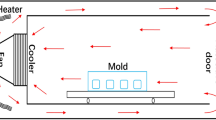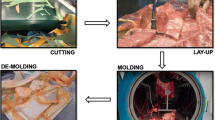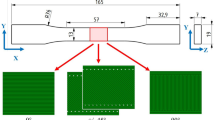Abstract
Composite manufacturing has proven to be a quintessential process for the improvement of a spectrum of industries from medical to automotive, and aerospace. Most composite manufacturing processes include a two-step process, lay-up, and autoclave curing. The autoclave process is often long and expensive. Therefore, improving its efficiency can reduce the production cost and increase the throughput significantly. However, there is a scarcity of studies in the literature that tackle production improvement of vacuum bag/autoclave molding processes. Thus, in this paper, in collaboration with an industry partner, the effect of quantity, location, and orientation of parts inside an autoclave on the curing cycle is investigated both computationally and experimentally. The objective is to improve the production rate without compromising quality. The quality of parts is being represented by their heat-up rate throughout the curing cycle. The results showed that, for a specific scenario, doubling the number of parts inside the autoclave could slow down the heat transfer without significantly affecting the heat-up rates. As a result, the lag could be negligible for the increase in the production rate that it provides.













Similar content being viewed by others
Data availability
Available in the “data deposition” file attached.
References
Lee S-Y, Springer GS (1988) Effects of cure on the mechanical properties of composites. J Compos Mater 22(1):15–29. https://doi.org/10.1177/002199838802200102
Peters PWM (1994) Influence of cure temperature and degree of surface treatment on transverse cracking and fibre/matrix bond strength in CFRP. J Compos Mater 28(6):507–525. https://doi.org/10.1177/002199839402800602
C. Gernaat, S. Alavi-Soltani, M. Guzman, A. Rodriguez, B. Minaie, and J. Welch, “Correlation between viscoelastic and mechanical properties for an out-of-autoclave polymer composite,” 2009
Alavi-Soltani S, Sabzevari S, Koushyar H, Minaie B (2012) Thermal, rheological, and mechanical properties of a polymer composite cured at different isothermal cure temperatures. J Compos Mater 46(5):575–587. https://doi.org/10.1177/0021998311415443
Cao Y, Cameron J (2007) The effect of curing conditions on the properties of silica modified glass fiber reinforced epoxy composite. J Reinf Plast Compos 26(1):41–50. https://doi.org/10.1177/0731684407069950
White SR, Kim YK (1996) Staged curing of composite materials. Compos A: Appl Sci Manuf 27(3):219–227. https://doi.org/10.1016/1359-835X(95)00023-U
Bowles KJ, Frimpong S (1992) Void effects on the interlaminar shear strength of unidirectional graphite-fiber-reinforced composites. J Compos Mater 26(10):1487–1509. https://doi.org/10.1177/002199839202601006
Tang C, Li Y, Dong X, He B (2020) A generalized alternating linearization bundle method for structured convex optimization with inexact first-order oracles. Algorithms 13(4):Art. no. 4. https://doi.org/10.3390/a13040091
Boey FYC, Lye SW (1992) Void reduction in autoclave processing of thermoset composites: part 1: high pressure effects on void reduction. Composites 23(4):261–265. https://doi.org/10.1016/0010-4361(92)90186-X
Liu L, Zhang B-M, Wang D-F, Wu Z-J (2006) Effects of cure cycles on void content and mechanical properties of composite laminates. Compos Struct 73(3):303–309. https://doi.org/10.1016/j.compstruct.2005.02.001
Olivier P, Cottu JP, Ferret B (1995) Effects of cure cycle pressure and voids on some mechanical properties of carbon/epoxy laminates. Composites 26(7):509–515. https://doi.org/10.1016/0010-4361(95)96808-J
Boey FYC, Lye SW (1990) Effects of vacuum and pressure in an autoclave curing process for a thermosetting fibre-reinforced composite. J Mater Process Technol 23(2):121–131. https://doi.org/10.1016/0924-0136(90)90152-K
Guo Z-S, Liu L, Zhang B-M, Du S (2009) Critical void content for thermoset composite laminates. J Compos Mater 43(17):1775–1790. https://doi.org/10.1177/0021998306065289
Mouritz AP (2000) Ultrasonic and interlaminar properties of highly porous composites. J Compos Mater 34(3):218–239. https://doi.org/10.1177/002199830003400303
Müller De Almeida SF, Chaves De Mas Santacreu A (1995) Environmental effects in composite laminates with voids. Polym Polym Compos 3(3):193–204
Costa ML, Rezende MC, De Almeida SFM (2005) Strength of hygrothermally conditioned polymer composites with voids. J Compos Mater 39(21):1943–1961. https://doi.org/10.1177/0021998305051807
Koushyar H, Alavi-Soltani S, Minaie B, Violette M (2012) Effects of variation in autoclave pressure, temperature, and vacuum-application time on porosity and mechanical properties of a carbon fiber/epoxy composite. J Compos Mater 46(16):1985–2004. https://doi.org/10.1177/0021998311429618
Struzziero G, Skordos AA (2017) Multi-objective optimisation of the cure of thick components. Compos A: Appl Sci Manuf 93:126–136. https://doi.org/10.1016/j.compositesa.2016.11.014
Wang Q, Wang L, Zhu W, Xu Q, Ke Y (2017) Design optimization of molds for autoclave process of composite manufacturing. J Reinf Plast Compos 36(21):1564–1576. https://doi.org/10.1177/0731684417718265
Hu J, Zhan L, Yang X, Shen R, He J, Peng N (2020) Temperature optimization of mold for autoclave process of large composite manufacturing. J Phys Conf Ser 1549:032086. https://doi.org/10.1088/1742-6596/1549/3/032086
Kluge N, Lundström T, Ljung A-L, Westerberg L, Nyman T (2016) An experimental study of temperature distribution in an autoclave. J Reinf Plast Compos 35(7):566–578. https://doi.org/10.1177/0731684415624768
Bohne T, Frerich T, Jendrny J, Jürgens J-P, Ploshikhin V (2018) Simulation and validation of air flow and heat transfer in an autoclave process for definition of thermal boundary conditions during curing of composite parts. J Compos Mater 52(12):1677–1687. https://doi.org/10.1177/0021998317729210
Slesinger N, Shimizu T, Arafath ARA, Poursartip A Heat transfer coefficient distribution inside an autoclave:10
Sturrock NS (1971) Localized boundary-layer heat transfer from external building surfaces. PhD Thesis, University of Liverpool
Rowley FB, Eckley WA (1932) Surface coefficients as affected by wind direction. ASHRAE Trans 38:33–46
Author information
Authors and Affiliations
Contributions
All authors contributed significantly to the work with the order provided.
Corresponding author
Ethics declarations
Conflict of interest
The authors declare that they have no conflict of interest.
Code availability
Available in the “data deposition” file attached.
Additional information
Publisher’s note
Springer Nature remains neutral with regard to jurisdictional claims in published maps and institutional affiliations.
Rights and permissions
About this article
Cite this article
Mirzaei, S., Krishnan, K., Al Kobtawy, C. et al. Heat transfer simulation and improvement of autoclave loading in composites manufacturing. Int J Adv Manuf Technol 112, 2989–3000 (2021). https://doi.org/10.1007/s00170-020-06573-3
Received:
Accepted:
Published:
Issue Date:
DOI: https://doi.org/10.1007/s00170-020-06573-3




